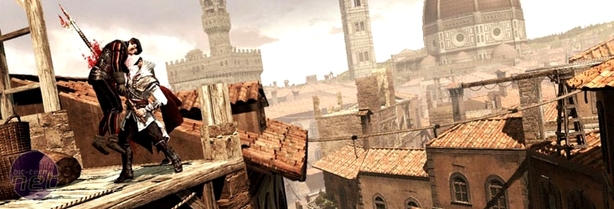
Fettuccini el Morte
It’s through Ezio’s eyes that most of Assassin’s Creed 2 takes place, with Desmond only showing up at the very beginning and end of the game to bookend the story.Unlike the first game there’s no switching back to Desmond’s perspective whenever the story demands a time lapse and for the considerable bulk of Assassin’s Creed 2 you’re completely disconnected from the modern day.
This is A Good Thing. While Desmond’s and Ezio’s stories are both interesting in their own rights, mixing them together in such a haphazard manner isn’t something that would work very well. The contrast between Altair’s freedom of movement and Desmond’s confinement was something we particularly loathed in the original, so it’s smart of Ubi to address that.
That goes doubly considering the muti-faceted nature of Ezio’s journey too, which starts off by focusing on a rivalry between his family and another in 15th century Italy before becoming a tale of vengeance and retribution. The story is just too large and rambling to withstand being so fragmented – though the scope is also a problem for players who want to focus on the efficiency implied by the title. There’s a lot to distract you in Assassin’s Creed 2.
More pressing an issue though is the simple fact that it takes a good three hours before you’re really in a position to attempt your first assassination. Until that point the story is focused on running errands for your father and mother, collecting eagle feathers for your little brother and beating up philanderers on behalf of your sister’s honour.
Admittedly, all the errand running and mini-quests are different and you won’t get bored racing against the clock or sitting through the brief cutscenes. The dialogue is snappy and fresh, with the occasional injection of humour such as when you’re introduced to your Uncle Mario or scalded by your mother for your chosen outlet against stress.
That Ezio’s father and brothers are all wrongfully executed for treason as part of a Templar conspiracy is something that’s both obvious and already been heavily publicised in pretty much every preview on the game, including ours. Rather than echoing the direct approach of Desmond’s introduction though, Ezio’s portion of the game meanders around needlessly and spends far too long getting players acquainted with specific tropes of the game design, such as collecting feathers.
It’s not until you’ve been playing for a good few hours that Ezio even hears mention of the Assassins or the Templars and even that occasion is drawn out despite how obvious the situation is to the player. The result is that Ezio’s story manages to feel both epic and bloated at the same time. It’s definitely a plus point that the vast array of characters are kept distinct and engaging, but it doesn’t detract from the fact that while the game is supposedly about assassinating people you actually don’t get to do that until very much.
Instead, just as with the first game, the bulk of your time is spent gathering information and spying on your victims. There are some particularly frustrating moments where Ezio has a clear vantage point on the entire Templar management, all of whom he tackles in the game, yet he stays his hand for no apparent reason. Five unarmed, evil men in a crypt underground where nobody can see them. You’d think an assassin equipped with more blades than brains would take advantage of that, but Assassin’s Creed 2 thinks otherwise.

MSI MPG Velox 100R Chassis Review
October 14 2021 | 15:04











Want to comment? Please log in.